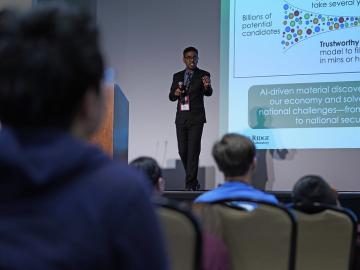
Filter News
Area of Research
- Advanced Manufacturing (8)
- Biological Systems (2)
- Biology and Environment (53)
- Building Technologies (2)
- Clean Energy (67)
- Computational Biology (1)
- Computational Engineering (1)
- Computer Science (6)
- Energy Sciences (1)
- Fusion and Fission (6)
- Fusion Energy (3)
- Isotopes (3)
- Materials (45)
- Materials for Computing (10)
- National Security (10)
- Neutron Science (16)
- Quantum information Science (1)
- Supercomputing (42)
News Type
News Topics
- (-) Artificial Intelligence (61)
- (-) Bioenergy (67)
- (-) Composites (17)
- (-) Frontier (26)
- (-) Materials (79)
- (-) Sustainable Energy (92)
- 3-D Printing/Advanced Manufacturing (73)
- Advanced Reactors (21)
- Big Data (44)
- Biology (78)
- Biomedical (40)
- Biotechnology (15)
- Buildings (39)
- Chemical Sciences (38)
- Clean Water (27)
- Climate Change (74)
- Computer Science (127)
- Coronavirus (28)
- Critical Materials (17)
- Cybersecurity (17)
- Decarbonization (55)
- Education (1)
- Emergency (2)
- Energy Storage (61)
- Environment (149)
- Exascale Computing (28)
- Fossil Energy (5)
- Fusion (40)
- Grid (46)
- High-Performance Computing (56)
- Hydropower (11)
- Irradiation (2)
- Isotopes (33)
- ITER (5)
- Machine Learning (33)
- Materials Science (81)
- Mathematics (9)
- Mercury (10)
- Microelectronics (3)
- Microscopy (31)
- Molten Salt (6)
- Nanotechnology (28)
- National Security (45)
- Net Zero (10)
- Neutron Science (76)
- Nuclear Energy (75)
- Partnerships (20)
- Physics (34)
- Polymers (17)
- Quantum Computing (25)
- Quantum Science (41)
- Renewable Energy (1)
- Security (12)
- Simulation (39)
- Software (1)
- Space Exploration (22)
- Statistics (2)
- Summit (37)
- Transformational Challenge Reactor (3)
- Transportation (62)
Media Contacts

At ORNL, a group of scientists used neutron scattering techniques to investigate a relatively new functional material called a Weyl semimetal. These Weyl fermions move very quickly in a material and can carry electrical charge at room temperature. Scientists think that Weyl semimetals, if used in future electronics, could allow electricity to flow more efficiently and enable more energy-efficient computers and other electronic devices.

The world’s fastest supercomputer helped researchers simulate synthesizing a material harder and tougher than a diamond — or any other substance on Earth. The study used Frontier to predict the likeliest strategy to synthesize such a material, thought to exist so far only within the interiors of giant exoplanets, or planets beyond our solar system.

Two ORNL teams recently completed Cohort 18 of Energy I-Corps, an immersive two-month training program where the scientists define their technology’s value propositions, conduct stakeholder discovery interviews and develop viable market pathways.

Researchers at the Department of Energy’s Oak Ridge National Laboratory and partner institutions have launched a project to develop an innovative suite of tools that will employ machine learning algorithms for more effective cybersecurity analysis of the U.S. power grid.

Brittany Rodriguez never imagined she would pursue a science career at a Department of Energy national laboratory. However, after some encouraging words from her mother, input from key mentors at the University of Texas Rio Grande Valley, or UTRGV, and a lot of hard work, Rodriguez landed at DOE’s Manufacturing Demonstration Facility, or MDF, at Oak Ridge National Laboratory.

Researcher Rocio Uria-Martinez was named one of four “Women with Hydro Vision” at this year’s HYDROVISION International 2024 conference taking place in Denver this week. Awarded by a committee of industry peers, the honor recognizes women who use their unique talents and vision to improve and advance the worldwide hydropower industry.

Oak Ridge National Laboratory scientists have developed a method leveraging artificial intelligence to accelerate the identification of environmentally friendly solvents for industrial carbon capture, biomass processing, rechargeable batteries and other applications.

Advanced materials research to enable energy-efficient, cost-competitive and environmentally friendly technologies for the United States and Japan is the goal of a memorandum of understanding, or MOU, between the Department of Energy’s Oak Ridge National Laboratory and Japan’s National Institute of Materials Science.

Researchers at ORNL and the University of Maine have designed and 3D-printed a single-piece, recyclable natural-material floor panel tested to be strong enough to replace construction materials like steel.

Prasanna Balaprakash, a national leader in artificial intelligence, or AI, spoke to some of the highest achieving students in the country at the National Science Bowl in Washington D.C.


